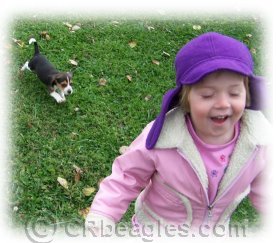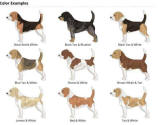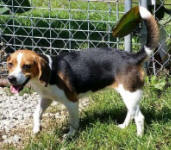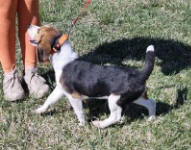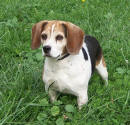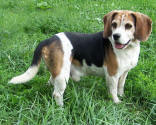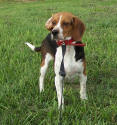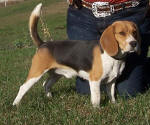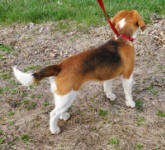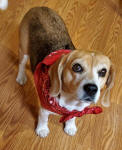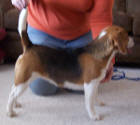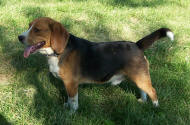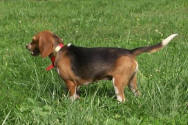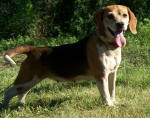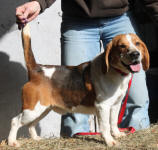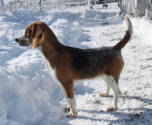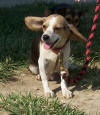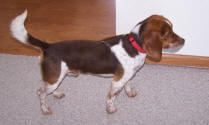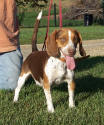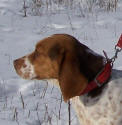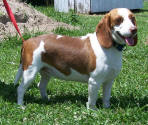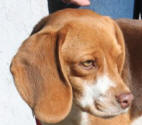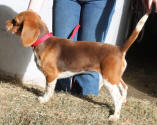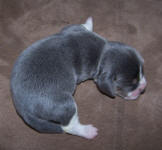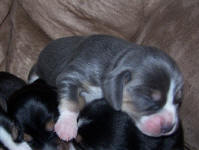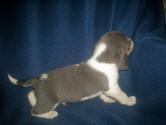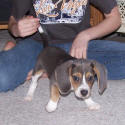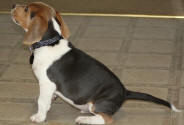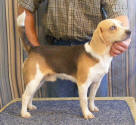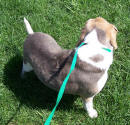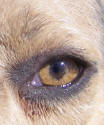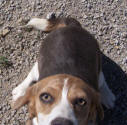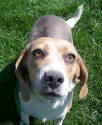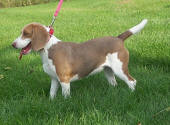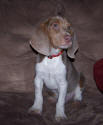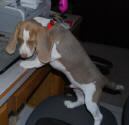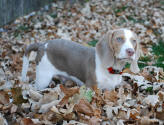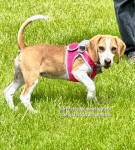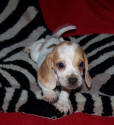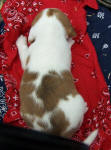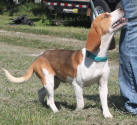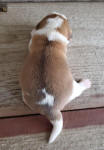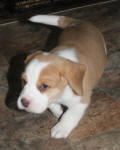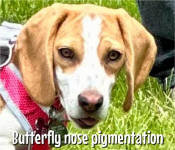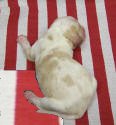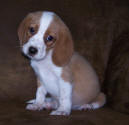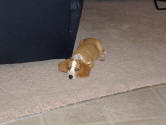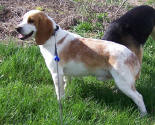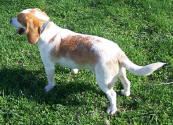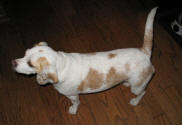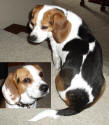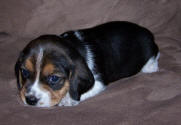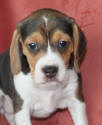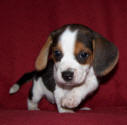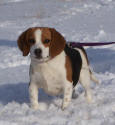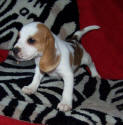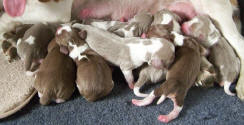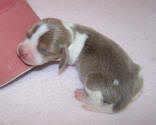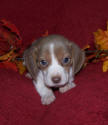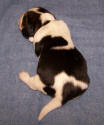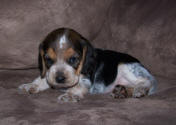What Colors Can Beagles Be?
Beagle colors are defined by each registration association, and so vary from
registry to registry. For example, the colors listed on the AKC registry form
are not the same as those on other associations' forms. A widely-accepted
definition of beagle color possibilities is that they can be "any hound color," which makes
the subject quite diverse.
Let's add to the confusion: Within each beagle genetic color grouping are also "shades" of
the same color and combinations of color genes. Regarding people, we know that there are a few basic hair colors
such as blonde, redhead, and brunette. But remember that there are dirty
blondes, dark blonde, strawberry blondes, etc. The same is true of beagles.
There are chocolate tri, silver tri, lilac tri, shaded tri, etc. A
red-based beagle can be lemon, red, tan....you can see the problem here.
:-)
Beagle colors are affected by quite a few genes, so I don't imagine that I'll
ever have all possible colors represented on this page due to the variety of
combinations (imagine for example a lemon with a blue gene). But, I'll put as many as
possible as we have photos available here.
This graphic (found on Facebook...I don't have the original source) "kind of"
shows some basic colors. But, scroll down for some real-life examples.
(Two colors plus white)
Tan, White, and Black Tri
There are several shades of chocolate beagles, from dark chocolate to having a
nearly red back. The darkest is a normal "chocolate" tri, with Liver tri
lighter or even light enough to look the same as Red and White (except for the
color of the nose). Chocolates have reddish/brownish noses, and not black
noses. Their eyes are typically lighter in color than standard tri colors
as well.
It is difficult to tell the difference between chocolate and liver beagle
puppies until they are around weaning age, although sometimes it can be
determined earlier if there are a chocolate and a liver to compare side by side
in the same litter.
Blue Tri (Silver Tri Color)
Other Tan and White beagles are true bi-colored (red based), without black tips
on the hairs on their backs. We've had several true tan and white puppies, and
I'll try to gather pictures to add to the Bi-Color section below soon.

The Red-Based Shades, aka Bi-Color
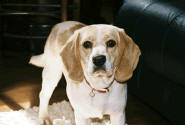
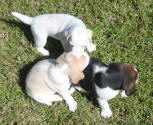
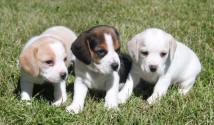
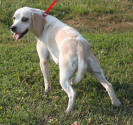
This lemon or tan and white adult (above) shows the typical golden patches of a lemon beagle. Her white
areas might be slightly off white (a light cream), or may be clear white. Her
back is uniformly gold in her color patches, without any black hairs or
black-tipped hairs. Her nose is black. The above dog might actually be a tan and
white, rather than a lemon.
The puppy pictures show a tan and white, a tri-color, and what I think may be a
lemon and white. The last photo is of that lightest-colored puppy at maturity.
Tan and White
Tan and White beagles are true bi-colored (red based),
without black tips on the hairs on their backs. Their
colored areas are tan or light orange, rather than dark
reddish orange. We've had several true tan and white
puppies, and I'll try to gather pictures to add here soon.
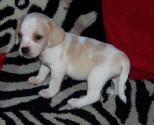
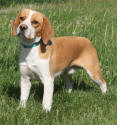
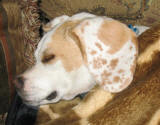
Typical Tri-Colors
Chocolate Tri Hare
Pied
Silver Lemon and White
Red and White Tan and White Merle
Puppy Color Changes
Back to Top
Examples of Markings
Ticking refers to freckles on the legs and in the colored areas. If there are
black ticks on the barrel/back of a dog, it can be referred to as "blue ticked."
If the freckles are red/brown, it is "red ticked." Ticking can also occur on the
legs. Hunting bloodlines are more often ticked, as the show bloodlines have been
selectively bred for white legs more so than with ticking.
Mottled can look like ticking. But mottled dogs will have mottled markings on
the pads of their feet as pups. They also may have a dark brownish gray nose,
rather than a black nose. Some say that a mottled dog's nose is also called a "butterfly
nose," because the middle half of the nose is lighter in color than the two
sides...but that is also true of Hare Pieds, so I'm not sure whether that is
accurate or not.

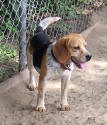
Red Ticked
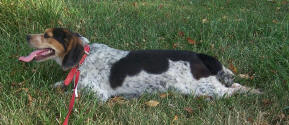
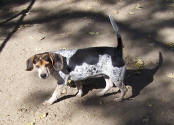
Blue Ticked
(White crossing over the back)
What will a puppy look like at maturity if it is born black and white? What if
it is born all white? This section, as it grows, will show the changes in colors
from birth to adulthood.
For each given color, the pictures are not necessarily the same dog. So
disregard the white markings, and look instead at the body colors. One thing to
note about white markings on the faces and shoulders/neck is that the white
areas will get a little smaller in proportion to the body size as the puppy
matures.
Tri-colored beagles are born black and white, with the brown on the head, hips,
and legs evolving as the puppy matures. White markings also reduce in proportion
on the head as the puppy matures.
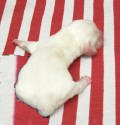

The adult on the right might actually be better referred to as a Tan and White.
I don't have a good picture of a confirmed lemon to show.
Lemon puppies are typically born nearly pure white, with no colored patches.
Some breeders advertise their red and white puppies as lemons, but
don't be fooled! If you are looking for a lemon and white, ask to see a newborn
picture. Lemon and white beagles look extremely similar to tan and white
bi-colored beagles.
Tan and White (so close to Lemon that I'm
using some of the same pictures temporarily)
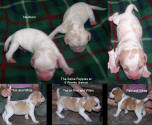
Comparison of birth colors to their 6-week colors, above.
(Tan and White, Red and White)
These puppies' mature colors were a little darker than the 6-week old photos
show.
Lilac Tri (also referred to as Khaki, Blue
Fawn and Mocha, but AKC uses the term "Lilac" for this color)
Purebred beagles do not come in merle.
Anyone making such a
claim has probably introduced another breed into their beagle
lines (such as dachshund), or has bought a puppy from a breeder
that has done so. This practice is seen in the so-called "pocket
beagles," where small dog breeds have been crossbred with beagles
to reduce size. In addition to introducing non-beagle colors, this
also possibly introduces health problems found in those other breeds.
On the other hand, some would argue that it allows for more
genetic diversity. This can be good, but it also can make it
hard to predict whether the puppy would look, behave/act like a
beagle, or like the other breed used to make the cross.
|
